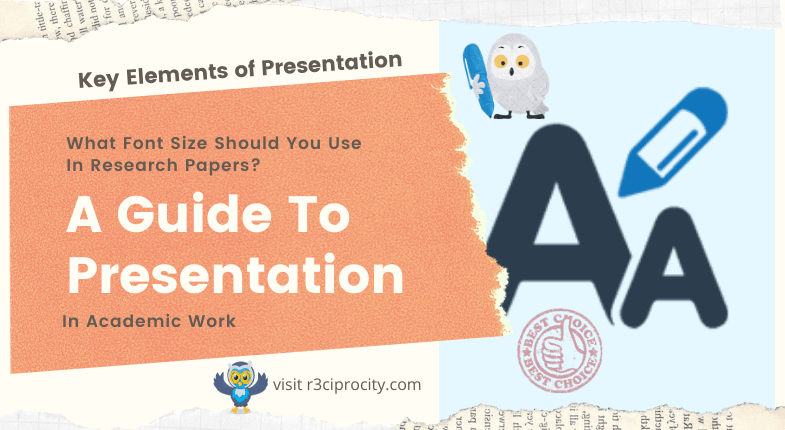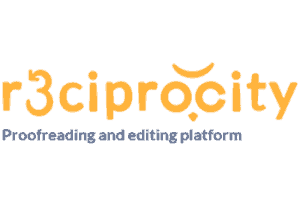
When it comes to presentation and how things look, the small details matter. A stain on a candidate’s suit at a job interview could be what the manager remembers when she’s making her final decision. Mismatched drawer handles in a kitchen remodel could be the reason why a couple doesn’t recommend the contractor to their friends. In the same way small details of presentation will impact on how well your research paper is received. Even font size. But how can you make sure your work is always received well?
What Font Size Should You Use In Research Papers?
In academic work, the standard and most widely accepted font is Times New Roman 12-point font size. But your most important consideration for presentation should be any standards or guidelines you have been given by your institution. Follow these rules, know your citation style, spend time perfecting your presentation and always ask someone to look over your work. An editor or proofreader, such as those at r3ciprocity.com, may catch mistakes you have missed.
Follow The Rules
Your research might be innovative and creative but the way you present it in your research paper shouldn’t be. When it comes to citation style guides and any guidelines given to you by your university you need to be a boring rule-follower. Bending, stretching or just plain breaking the rules when it comes to things like references, layout and word count is a big no. It gives the impression that you are someone who cannot follow instructions or work within limitations and will distract from the content of your paper.
The first step in following the rules is knowing exactly what they are. Dig out any information you have been given on this topic. Search your university portal, journal website, or relevant website. Do not make assumptions or guess. Unless you are 100% sure that you know what is expected of you then ask. Ask friends or peers who are also submitting research papers. Ask your advisor. It is worth a moment of awkwardness to avoid missing some vital piece of information.
A big part of what you need to know is which citation style you are expected to use. No one reading your work will be impressed if they told you to use MLA and you are using APA. They will also not be impressed if you use a citation style inaccurately or inconsistently. If it is the first time you are using a particular style then find some examples of it being used correctly and refer to them regularly.
Key Elements of Presentation
Your first point of reference should ALWAYS be any guidelines you have been given but some universal and widely accepted norms for academic work presentation include:
Standard white 8.5 x 11-inch paper
1-inch margins on all sides
Times New Roman 12-point font size
A table of contents and headings/ subheadings to improve readability in papers larger than 5-6 pages. (You may not need to in journal articles)
Clear display of the title, your name and other information such as student ID number or advisor’s name
Page numbers
Perfection Is Your Friend
When actually writing the content of your research paper, perfection is your enemy. Any attempt to try and make your work perfect will most likely hinder progress and cause you to overthink. But, when the words are written and it is time to prepare your work for submission, perfection is your friend.
Nothing in this world will ever truly be perfect. Your research paper will never be perfect. But with care, consideration and time you can ensure that your paper adheres exactly to any requirements and citation styles you have been given. Perfection in the presentation of academic work is ticking all the boxes of what your reader wants to see. And that is something you can do. You can make sure that your title page, in text citations and bibliography are all formatted in the expected way. You can check and double check every full stop, page number and indent.
Why go to all this extra effort? Because your research is the point of your research paper and you want nothing to distract or frustrate your reader. Well-presented and formatted work is easier to read and navigate. It makes both the research and you as the researcher appear more professional.
What Not To Do
A well-presented research paper will often impress anyone who reads it. But, unfortunately, the opposite is also true. A badly presented research paper will not be received well, even if the actual ideas and work it contains are extraordinary.
A major mistake in research paper presentation is not citing sources correctly. Your research, no matter what the subject, will mention the ideas, writings and work of others. All of these sources need to be properly referenced in the format expected by your citation style. Not doing so will always make your work look unprofessional and in some cases may lead to concerns about plagiarism.
Not sticking to the word limit for your research paper is another common mistake. By greatly exceeding your word limit or failing to reach it you give the impression that you don’t know how to follow guidelines or work within limitations. Sometimes you will have a word limit with acceptable boundaries, for example 5000 words plus or minus 10%. If you have been given a boundary your word count needs to be within it, between 4500 and 5500 words for the example. If you are not given a boundary then stay as close to the given word count as you can and make sure you do not go more than 10% over or under.
Yet another big mistake is submitting a research paper that no one else has read. When you read your own work you will quite often miss small mistakes, reading what you think it should say rather than what is actually on the page. Then you submit an important paper with disordered grammar, spelling mistakes and an unfinished paragraph you forgot about. Don’t let this happen – find someone to read your work before you submit it.
Affordable Proofreading / Editing
A proofreader or editor is someone who reads the work of someone else and suggests changes to make the writing better. This could be a friend, flatmate, classmate, colleague or family member. They do not have to be an expert in your subject or necessarily understand all the concepts you are writing about. All they need to do is read your work and highlight any mistakes or areas that could be improved.
Another option for help improving your writing is r3ciprocity.com. We are a unique online platform that connects editors with people who need an editor to look over their work.
Simply create an account, buy some credits and upload your work. Within a few days it will be sent back to you edited by another member of the r3ciprocity.com platform. All editors have been approved by r3ciprocity.com admin and consistently provide high quality editing for their peers. Go to How To Get Feedback On Your Writing On R3ciprocity.com for more details on uploading your work to be edited.
We are always looking for more r3ciprocity.com editors. If you think you have what it takes to help others improve their writing then go to How Do You Perform A Test Review on R3ciprocity? for a step-by-step guide to starting the process.
Once you are approved as a r3ciprocity.com editor you will earn credits for editing the work of others. These credits can be used to get free editing of your own work through the platform. This is the reciprocity of r3ciprocity.com. Credits can also be saved up and transferred into real money.
More from the r3ciprocity blog:
